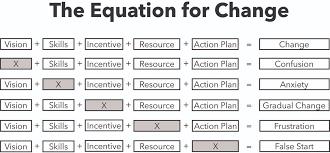Making sense of organizational resistance in change management implementation
Organizational resistance in change implementation is experienced at the personal level – but is often the result of complex inter-actions with external “organizational” entities. Often it can be difficult – challenging, complex, frustrating, inconceivably ambiguous. And sustained resistance can sometimes lead to where there’s seemingly no longer any point in asking the question why it’s occurring.
But before throwing everything out, here’s 5 things to ask yourself about resistance in the organization to make sense of what may be at play – and insights that might be gained in consequence.
What’s a useful way to think of understanding resistance at the organization level? Here is one way to frame your inquiry. (At this point, you may find yourself resisting the following invitation…!)

Have a look at the Change Equation (modified, originally from Beckhard-Harris "Dissatisfaction" model; This version of the model employs additions not multipliers and for the purposes of this note, a change does not automatically go to zero if there is resistance). Apply the framework by asking yourself whether the organizational resistance you may be experiencing in your change stems from any particular aspect of the model that leads to successful implementation. Leaving aside interactions across the model’s 5 dimensions, each on its own can provide a lens into resistance at play in your change.
Lack of clear vision: Resistance likely stems from perceptions around sponsorship of the change. Either the risk is too high or the resources aren’t there – but sponsorship results in a clear vision when it’s intention – skin in the game – is present.
Lack of required skills: Not enough? Not enough available at the right price? If no one is drawn to the effort it links to the lack of clear vision mentioned above – or the case for change is not articulated or translated sufficiently convincingly.
Lack of incentives: Benefits and costs in the change are likely severely out of balance, or worse, excessively unfairly shared. If so, you are likely working with 2nd or 3rd best outcomes – which take time, and which in urgent situations, no one has. Emergencies need to be dealt with, but everyone needs time to digest or find sufficiently plausible alternatives to worst-case outcomes.
Lack of sufficient resources: Dynamics here are similar to those around required skills. Sponsors normally include those providing the required risk capital. If so, very often the case for change isn’t sufficiently clear or compelling resulting in an inability to attract minimum required resources.
Lack of an action plan: Or more likely insufficient buy-in for it. The most frequent disconnect in implementation plans is “good enough” links between the center (those running the change) and the field or “operations” (those implementing it). Buy-in for implementation is change street lingo for culture eats strategy.
One observation over 25 years in change implementation is that a good proportion – say over 80% of the time, the subtleties of having a clear vision continue to underlie organizational resistance to change implementation. It is no wonder. Today a good majority of aspects of organizational life are subject to much higher uncertainty currently and going forward than at any time previously. Ask yourself where CEO’s rank change and transformation risk today vs 10 years ago.
Clearly, organizational resistance to change in implementation is a complex topic.
The idea here is not to diminish that complexity in any way.
This note aims more at sense-making of the complexity of resistance at the organizational level. It’s usefulness has obvious limitations. Hopefully in the best of cases, even crude insights can contribute to more successful transition efforts.
For more information on how to manage resistance and ChangeVU's digital implementation platform visit https://www.changevu.com/changemanagementadvisory.html
#changemanagement #dataanalytics #changeimplementation #businesstransformation